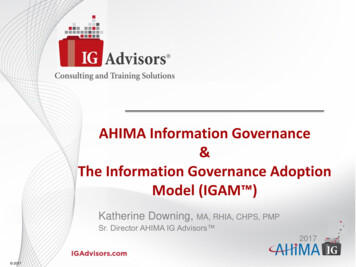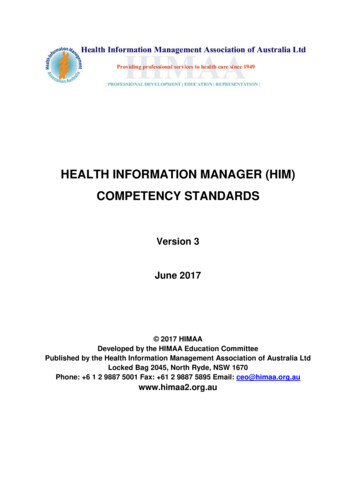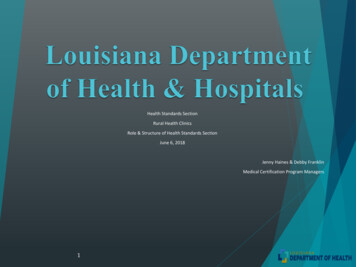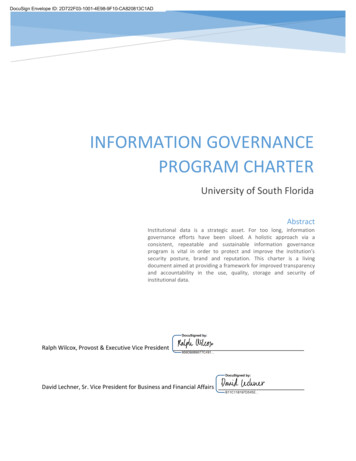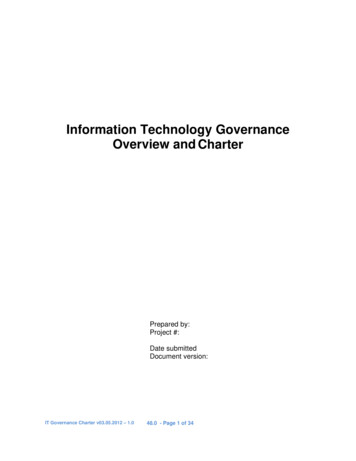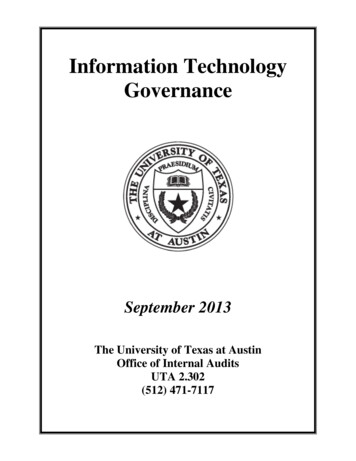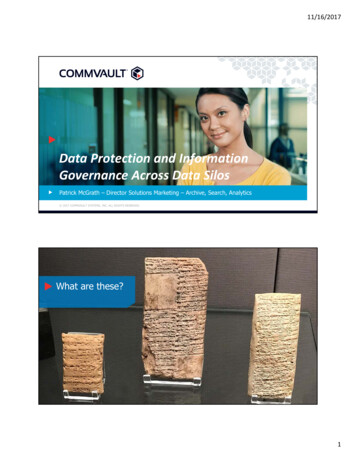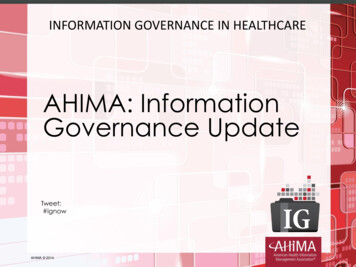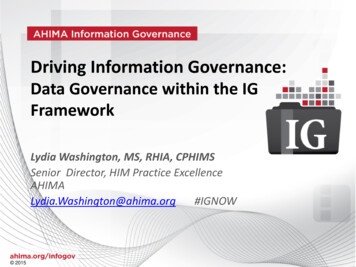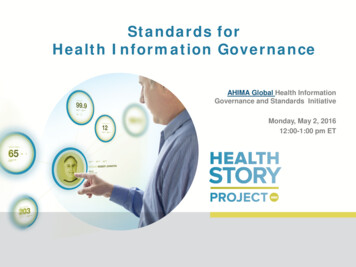
Transcription
Standards forHealth Information GovernanceAHIMA Global Health InformationGovernance and Standards InitiativeMonday, May 2, 201612:00-1:00 pm ET
SpeakersLinda Bailey-Woods, RHIA, CPHIMSPrincipal, Health IT Consulting, Plante Moran.E-mail: linda.bailey-woods@plantemoran.comSandra Huyck, RHIT, CCS-P, CPC, CPC-HCompliance Audit Specialist, Beaumont Health.E-mail: sandra.huyck@beaumont.orgLee Wise, MS, RHIA, CHCOCDI/Coding Supervisor, Carson Tahoe HealthE-mail: lee.wise@carsontahoe.org
AcknowledgementsAHIMA Task Force: HIT Standards for HIM PracticesKathleen Addison, Alberta HealthServicesLinda Bailey-Woods, Plante MoranKevin Baldwin, UCLASusan Clark, eHealthcare ConsultingAlane Combs, Coastal HealthcareVicki Delgado, Kindred HospitalAlbuquerqueElisa Gorton, St.Vincent's Medical CenterAaron Haskett, Data & Coding ComplianceConsultantSandra Huyck, Beaumont HealthKatherine Lusk, Dallas Children’s MedicalCenterSatyendra Kaith, Kaplan HigherEducation GroupSusan Lucci, Just AssociatesLori McNeil Tolley, Boston Children's HospitalSharon Meyer, Ministry Health CareMegan Munns, Just AssociatesNeysa Noreen, Children's Hospitals and Clinicsof MinnesotaSandra Nunn, KAMC ConsultingMichael Nusbaum, M.H. Nusbaum & AssociatesLtd.Anna Orlova, AHIMABill Reisbick, Esq., Newcastle WA.Harry Rhodes, AHIMADeAnn Tucker, Owensboro HealthDiana Warner, AHIMAValerie Wilson, HCA Information TechnologyLee Wise, Carson Tahoe Health
AHIMAThe American Health Information Management Association(AHIMA) is the premier association of health informationmanagement (HIM) professionals worldwide. Serving 52 affiliatedcomponent state associations and more than 103,000 healthinformation professionals, it is recognized as the leading source of"HIM knowledge," a respected authority for rigorous professionaleducation and training.Founded in 1928 to improve health record quality, AHIMA hasplayed a leadership role in the effective management of healthdata and medical records needed to deliver quality healthcare tothe public.
Outline The Need Collaboration with Health IT Vendors Approach– Business Requirements– HIM Practice Checklists– Use Cases– Standards Review
Outline The Need Collaboration with Health IT Vendors Approach– Business Requirements– HIM Practice Checklists– Use Cases– Standards Review
The Need: Challenges with HIT Adoption Health Information Systems (HIS) design flaws Poor HIS usability and improper use Inappropriate documentation capture in HIS Errors related to design and use of clinical decision support Errors related to faulty support of HIM practices in HIS Outdated organizational policies to support information capture,management, sharing and use in electronic environment because thesepolicies were developed for the paper-based environment Inadequate training for HIM personnel and clinicians to operate HIS and Errors related to vendor’s upgrades of HIS systems (product releasecycle management)American Health Information Management Association (AHIMA) and IntegratingHealthcare Enterprise (IHE). Health Information Standards for Health InformationPractices. White Paper. 2015. URL: http://qrs.ly/lb4vec0
The Need: Patient Care Safety and HITNational Institute of Standards and Technology (NIST). Technical Evaluation, Testing, andValidation of the Usability of Electronic Health Records: Empirically Based Use Cases forValidating Safety-Enhanced Usability and Guidelines for Standardization. NISTIR 7804-1 . September 2015.URL: http://dx.doi.org/10.6028/NIST.IR.7804-1
Addressing Challenges with HIT AdoptionAddressing issues with EHR adoption:1. Clinically relevant information is not available atthe task at hand2. Inadequate documentation3. Inaccurate information and4. Irretrievable informationNational Institute of Standards and Technology (NIST). Technical Evaluation, Testing, and Validationof the Usability of Electronic Health Records: Empirically Based Use Cases for Validating SafetyEnhanced Usability and Guidelines for Standardization. NISTIR 7804-1 . September 2015. URL:http://dx.doi.org/10.6028/NIST.IR.7804-1
Addressing Challenges with HIT AdoptionHealth Information Systems Should SupportInformation Governance (IG) PracticesStandards Developers Should be Informed about IGPracticesHealth Information Systems (HIS)Built Based on Standards Should Support IG Practices
Addressing HIT Adoption ChallengesThrough Collaboration with HIT Vendors2015 AHIMA-IHE White PaperHIT Standards for HIMPracticesPublished September 18, 2015
Outline The Need Collaboration with Health IT Vendors Approach– Business Requirements– HIM Practice Checklists– Use Cases– Standards Review
AHIMA Collaborates with HIT VendorsTo address challenges with HIT adoption, in 2015, AHIMA joined theIntegrating the Healthcare Enterprise (IHE).IHE is an international collaborative of HIT vendors, professionalsassociations and governmental entities to develop interoperabilitystandards in healthcare to improve the quality, value, and safety ofhealthcare by enabling rapid, scalable, and secure access to healthinformation at the point of care.IHE engages public and private entities to develop, test, implement,and use standards-based solutions for all health information needs.
9Clinicians, Health Information Managers,Public Health andSoftware DevelopersWorking Together to DeliverInteroperable Health Information Systemsin the Enterpriseand Across Care Settings
IHE Develops Interoperability StandardsIntegrating the Healthcare Enterprise (IHE) specifiesharmonized interoperability standards (Technical Frameworks,Integration Profiles, Content Profiles) for: Information Technology Infrastructure (ITI) Patient Care Coordination (PCC) Laboratory Cardiology Radiology Quality Research and Public Health (QRPH) Medical Devices and other domainsIntegrating the Healthcare Enterprise (IHE)
IHE ParticipantsIntegrating the Healthcare Enterprise (IHE)
IHE Connectathon:Interoperability Standards Testing Event NIST serves as a proctorfor the tests. Passing tests is a prerequisite to participation inHIMSS InteroperabilityShowcase . IHE Connectathons areheld in:– North America– Europe– Asia and Japan– AustraliaIntegrating the Healthcare Enterprise (IHE)
Successfully Tested StandardsDemonstrated at theHIMSS Interoperability Showcase Major HIT event conducted atHealth InformationManagement and SystemsSociety (HIMSS) AnnualConventions. Scripted Use Case Scenariosare played at the vendors’kiosks. Attended by thousands ofclinicians and CIOs fromvarious healthcareorganizations and practicesworldwide.IHE profiles are the foundation of the HIMSSInteroperability Showcase HIMSS
Outline The Need Collaboration with Health IT Vendors AHIMA Approach– Business Requirements– HIM Practice Checklists– Use Cases– Standards Review
AHIMA-IHE White Paper:Health IT (HIT) Standards for HIMPracticesThe White Paper -- part of AHIMA’s globallyfocused Information Governance (IG)initiative -- marks the first time effort for HITvendors and HIM professionals to worktogether to ensure that interoperability will beaddressed from an HIM perspective.“Identifying HIM practice needs and a meansto address them in standards is the first stepin achieving our shared goal of theinteroperability and overall governance ofhealth information” (AHIMA, 2015).American Health Information Management Association (AHIMA) and IntegratingHealthcare Enterprise (IHE). Health Information Standards for Health InformationPractices. White Paper. 2015. URL: http://qrs.ly/lb4vec0
Define: Information Governance (IG)“Recognized as a healthcareimperative, informationgovernance (IG) establishesthe policy-level rules,investment prioritiesand accountabilities formanaging the lifecycleof information.”In healthcare – Informationis necessary for safe, quality andeffective care ofindividuals, for improving the healthof population(s) for reducing per capitacosts of healthcarewhich requiresoperational excellenceAHIMA. Information Governance Principles for Healthcare (IGPHC). Chicago, IL.2014. URL: http://www.ahima.org/ /media/AHIMA/Files/HIMTrends/IG Principles.ashxSource: D. Green. Presentation at Health Datapalooza, June 2014
AHIMA Information Governance Framework:Organizational Policies & Processes for Information Lifecycle
From IG Principles to HIT Standards:Our Methodology1. Specify business requirements by Information GovernancePrinciple2. Specify functional requirements for HIT products via HIMPractice Checklist and specific Use Cases by InformationGovernance Principle3. C onduct standards gap analysis by Information GovernancePrinciple4. Develop recommendations for developing HIT standards tosupport HIM practicesAmerican Health Information Management Association (AHIMA) and IntegratingHealthcare Enterprise (IHE). Health Information Standards for Health InformationPractices. White Paper. 2015. URL: http://qrs.ly/lb4vec0
From IG Principles to HIT Standards:Our MethodologyIGPrinciplesHIM BusinessRequirementsby PrincipleHIMPracticeChecklistUseCasesAmerican Health Information Management Association (AHIMA) and IntegratingHealthcare Enterprise (IHE). Health Information Standards for Health InformationPractices. White Paper. 2015. URL: http://qrs.ly/lb4vec0HITStandards
Outline The Need Collaboration with Health IT Vendors Approach– Business Requirements– HIM Practice Checklists– Use Cases– Standards Review
From IG Principles to HIT Standards:Business abilityRetentionDispositionHIM BusinessRequirements byPrincipleSpecification of BusinessRequirements by IG PrincipleUnder public commentthrough June 13, 2016
Specifying Business Requirements:DefinitionPrinciple of Health Information Availability: Business RequirementsDefinitionHealth Information Availability is defined as the ability of an organizationto maintain information in a manner that ensures timely, accurate, andefficient retrieval of information by authorized entity. For example,information shall be available upon request by any authorized entity in therequired output format (e.g. a viewable display for online and paper-basedoutput).American Health Information Management Association (AHIMA). Specification ofBusiness Requirements for AHIMA Information Governance Principles for HealthCare (IGPHC). Draft for Public Comments. May 2016.
Specifying Business RequirementsHealth Information Availability: Business Requirements1. Ability to capture and maintain information in a manner that ensures timely, accurate (complete and correct), and efficient access andretrieval. – See Integrity #1, #5, Protection #9, Accountability #7, Transparency #52. Ability to access information across various systems (electronic and manual) and across patient populations, payers, labor resourcemanagement and research . This includes the abilities to search, identify, locate, and retrieve (see item 3 below) the information required tosupport organization’s ongoing activities via queries. This requirement is focused on how information from various sources is accessed. –See Integrity #5,#7, Retention #1,#63. Ability to search, identify, locate and retrieve individual’s specific information in continually expanding volumes of information and acrossmultiple systems including various electronic HIT, data warehouses, payer data systems, business and research information systems, andmanual repositories (paper-based document locations, storages, etc.). This requirement is focused on tracking sources where informationresides (HITs, other HICT products and manual repositories). – See Integrity #54. Ability to assemble (via search, identify, locate and retrieve) information in a consistent and coordinated fashion (timely and accurate(complete and correct)) from disparate electronic systems, both internal and external to the organization. – See Integrity #55. Ability to present/provide information for a specific purpose from disparate electronic systems, both internal and external to theorganization. – See Integrity #5, #156. Ability to link (semantically and contextually), map, couple, group or integrate clinical and business information in a timely, accuratemanner to support organizational business requirements. – See Integrity #5, #7, #15, & #167. Ability to address multiple demands for having the right information available at the right time for the right requestor.8 Ability to access information created with legacy hardware and software systems within an organization. In case of impending systemobsolescence, information with organizational value should be migrated to currently supported hardware and/or converted/migrated into acompatible format from non-compatible media (MAC vs PC) and non-compatible software versions. See Integrity #5American Health Information Management Association (AHIMA). Specification ofBusiness Requirements for AHIMA Information Governance Principles for HealthCare (IGPHC). Draft for Public Comments. May 2016.
Specification of HIM BusinessRequirementsInformation Governance Principles:Business Requirements2015 (Updated in 2016)20161.Information availability 4.Information accountability2. Information integrity5. Information compliance3. Information protection 6. Information transparency7. Information retention8. Information dispositionAmerican Health Information Management Association (AHIMA). Specification ofBusiness Requirements for AHIMA Information Governance Principles for HealthCare (IGPHC). Draft for Public Comments. May 2016.
Outline The Need Collaboration with Health IT Vendors Approach– Business Requirements– HIM Practice Checklists– Use Cases– Standards Review
Functional Requirements by IG Principle:HIM Practice Checklist Based on the literature review we developed HIMPractice Checklist of HIM work activities by IGBusiness Requirement. Checklist specifies HIM best practices in executingbusiness requirements.American Health Information Management Association (AHIMA). Specification ofChecklists and Use Cases for AHIMA Information Governance Principles for HealthCare (IGPHC). Work in Progress. 2016.
Functional Requirements by IG Principle:Example of HIM Practice ChecklistAmerican Health Information Management Association (AHIMA). Specification ofChecklists and Use Cases for AHIMA Information Governance Principles for HealthCare (IGPHC). Work in Progress. 2016.
Functional Requirements by IG Principle:Use Cases Based on the checklist, we developed the HIM PracticeUse Cases that specifies HIM work activities (actions)that require the use of information technology.American Health Information Management Association (AHIMA). Specification ofChecklists and Use Cases for AHIMA Information Governance Principles for HealthCare (IGPHC). Work in Progress. 2016.
Outline The Need Collaboration with Health IT Vendors AHIMA Approach– Business Requirements– HIM Practice Checklists– Use Cases– Standards Review
HIM Use CasesHIM Use Cases for HIT Standards20151. All documents in the episode of carerecord are accounted for2. Episode of care record is complete andclosed3. Release of Information (ROI) to externalrequestor4. Audit for the episode of care record5. Audit for the ROI20161. Patient registration2. Copy and paste3. Data quality4. Patient matching5. Transition of careAmerican Health Information Management Association (AHIMA). Specification ofChecklists and Use Cases for AHIMA Information Governance Principles for HealthCare (IGPHC). Work in Progress. 2016.
Use Case Example: Patient RegistrationAmerican Health Information Management Association (AHIMA). Specification ofChecklists and Use Cases for AHIMA Information Governance Principles for HealthCare (IGPHC). Work in Progress. 2016.
Outline The Need Collaboration with Health IT Vendors AHIMA Approach– Business Requirements– HIM Practice Checklists– Use Cases– Standards Review
Preliminary Standards Gap Analysis in 2015ASTM E-31 Standards on HIM PracticesIHE IT Infrastructure (ITI) Technical Framework Standardso Cross-Document Workflowo Cross-Document Sharingo Privacy and SecurityHL7 Standardso Electronic Health Record (EHR) Functional Modelo EHR Record Management/Evidentiary Supporto EHR Interoperabilityo Mobile Healtho Community Based Collaborative CareISO Technical Committee (TC) 215 Health Informatics Standardso Privacy and SecurityAmerican Health Information Management Association (AHIMA) and IntegratingHealthcare Enterprise (IHE). Health Information Standards for Health InformationPractices. White Paper. 2015. URL: http://qrs.ly/lb4vec0
Detailed Standards Gap Analysis:IHE Standards XDS: ITI-61 Register On-Demand Document EntryXDS: ITI-52 Update Document Set (Metadata Update Supplement)XDS: ITI-62 Delete Document Set (Metadata Update Supplement)XCDR: ITI-80 Cross-Gateway Document Provide (Supplement)XDS: ITI-43 Retrieve Document SetXCA: ITI-39 Cross Gateway RetrieveXDM: ITI-32 Distribute Document Set on MediaXDS: ITI-18 Registry Stored QueryXCA: ITI-38 Cross Gateway QueryMPQ: ITI-51 Multi-Patient QueryXCF: ITI-63 Cross Gateway FetchMHD: ITI-65 Provide Document BundleMHD: ITI-66 Find Document ManifestsMHD: ITI-67 Find Document ReferencesMHD: ITI-68 Retrieve DocumentIntegrating the Healthcare Enterprise (IHE)
Detailed Standards Gap Analysis in 2016:Selected IHE Standards1. IHE ITI White Paper: Template for Cross-DocumentSharing Affinity Domain Deployment Planning2. Patient Identifier Cross-Referencing (PIX)3. Patient Demographics Query (PDQ)4. Basic Patient Privacy Consents (BPPC)5. Advanced Patient Privacy Consents (APPC)Integrating the Healthcare Enterprise (IHE)
RecommendationsHIM Professionals Join AHIMA Standards Task Force to Comment on AHIMA Specification of HIM BusinessRequirements by IG Principle Harmonize/standardize HIM practices via Checklists Define HIM needs for HIT standards via Use Cases Inform the development of HIT standards at IHEStandards Development Organizations (HL7, ISO) Enable standard development activities to support HIMpractices Address necessary revisions in existing HIT standards Develop new HIT standards that address HIM needs
Join AHIMA StandardsTask Force Efforts: Recap1. Specification of HIM Business Requirements for All 8Information Governance Principles – Public Comments, May16-June 232. Specification of HIM Practice Checklists and Use Cases –Work in Progress3. IHE Standards Review – Work in ProgressFind documents listed above at AHIMA Information Governance Standards ProjectWiki. URL:http://wiki.ihe.net/index.php?title HIT Standards for HIM Practices2016#ProjectDescription
Help WantedAHIMA Standards Task Force need subject matter experts (SMEs) with theexpertise in legal aspects of information management and use to work on standardsfor policy representation in HIT products patient identity management to work on patient identification andmatching standards information privacy and security to work on patient consent standards clinical documentation improvement (CDI) and coding to work onterminology standards data quality and documentation integrity to work on documentmanagement standards health information exchanges to work on information sharing standardsand so on.
Join AHIMA Standards Task ForceFor more information contact:Diana Warner, MS, RHIA, CHPS, FAHIMADirector of HIM Practice Excellence, AHIMADiana.Warner@ahima.orgHarry Rhodes, MBA, RHIA, CHPS, CDIP, FAHIMADirector of National Standards, AHIMAHarry.Rhodes@ahima.org
Resources1. American Health Information Management Association (AHIMA)and Integrating Healthcare Enterprise (IHE). Health InformationStandards for Health Information Practices. White Paper. 2015.URL: http://qrs.ly/lb4vec02. AHIMA Information Governance Standards Project Wiki. URL:http://wiki.ihe.net/index.php?title HIT Standards for HIM Practices2016#Project Descript
Standards for Health Information Governance AHIMA Global Health Information Governance and Stan
